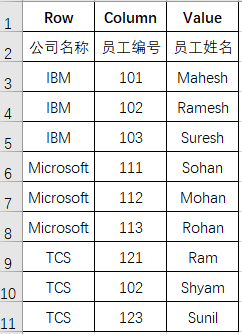guava学习:guava集合类型-table
最近学习了下guava的使用,这里简单记录下一些常用并且使用的工具类把。
看到table的使用时候真的是眼前一亮,之前的代码中写过很多的Map<String,Map<String,String>> 这种格式的代码,这种阅读起来非常的不友好,甚至都不知道map中的key到底是什么还要联系上下文联想才可以,而table类型的出现彻底解决掉了这个麻烦。
Table支持 row、column、value 我们把上面定义的map结构想象成一张数据表就可以了:
Table<R,C,V> == Map<R,Map<C,V>>
下面先让我们来看一张数据表吧,结合数据表来编写我们的代码:

| S.N. | 方法 & 描述 |
|---|---|
| 1 | Set<Table.Cell<R,C,V>> cellSet() 返回集合中的所有行键/列键/值三元组。 |
| 2 | void clear() 从表中删除所有映射。 |
| 3 | Map<R,V> column(C columnKey) 返回在给定列键的所有映射的视图。 |
| 4 | Set<C> columnKeySet() 返回一组具有表中的一个或多个值的列键。 |
| 5 | Map<C,Map<R,V>> columnMap() 返回关联的每一列键与行键对应的映射值的视图。 |
| 6 | boolean contains(Object rowKey, Object columnKey) 返回true,如果表中包含与指定的行和列键的映射。 |
| 7 | boolean containsColumn(Object columnKey) 返回true,如果表中包含与指定列的映射。 |
| 8 | boolean containsRow(Object rowKey) 返回true,如果表中包含与指定的行键的映射关系。 |
| 9 | boolean containsValue(Object value) 返回true,如果表中包含具有指定值的映射。 |
| 10 | boolean equals(Object obj) 比较指定对象与此表是否相等。 |
| 11 | V get(Object rowKey, Object columnKey) 返回对应于给定的行和列键,如果没有这样的映射存在值,返回null。 |
| 12 | int hashCode() 返回此表中的哈希码。 |
| 13 | boolean isEmpty() 返回true,如果表中没有映射。 |
| 14 | V put(R rowKey, C columnKey, V value) 关联指定值与指定键。 |
| 15 | void putAll(Table<? extends R,? extends C,? extends V> table) 复制从指定的表中的所有映射到这个表。 |
| 16 | V remove(Object rowKey, Object columnKey) 如果有的话,使用给定键相关联删除的映射。 |
| 17 | Map<C,V> row(R rowKey) 返回包含给定行键的所有映射的视图。 |
| 18 | Set<R> rowKeySet() 返回一组行键具有在表中的一个或多个值。 |
| 19 | Map<R,Map<C,V>> rowMap() 返回关联的每一行按键与键列对应的映射值的视图。 |
| 20 | int size() 返回行键/列键/表中的值映射关系的数量。 |
| 21 | Collection<V> values() 返回所有值,其中可能包含重复的集合。 |
下面是根据上面的表格写的Demo
/* * Company: IBM, Microsoft, TCS * IBM -> {101:Mahesh, 102:Ramesh, 103:Suresh} * Microsoft -> {101:Sohan, 102:Mohan, 103:Rohan } * TCS -> {101:Ram, 102: Shyam, 103: Sunil } * * */ //create a table Table<String, String, String> employeeTable = HashBasedTable.create(); //initialize the table with employee details employeeTable.put("IBM", "101","Mahesh"); employeeTable.put("IBM", "102","Ramesh"); employeeTable.put("IBM", "103","Suresh"); employeeTable.put("Microsoft", "111","Sohan"); employeeTable.put("Microsoft", "112","Mohan"); employeeTable.put("Microsoft", "113","Rohan"); employeeTable.put("TCS", "121","Ram"); employeeTable.put("TCS", "102","Shyam"); employeeTable.put("TCS", "123","Sunil"); //所有行数据 System.out.println(employeeTable.cellSet()); //所有公司 System.out.println(employeeTable.rowKeySet()); //所有员工编号 System.out.println(employeeTable.columnKeySet()); //所有员工名称 System.out.println(employeeTable.values()); //公司中的所有员工和员工编号 System.out.println(employeeTable.rowMap()); //员工编号对应的公司和员工名称 System.out.println(employeeTable.columnMap()); //row+column对应的value System.out.println(employeeTable.get("IBM","101")); //IBM公司中所有信息 Map<String,String> ibmEmployees = employeeTable.row("IBM"); System.out.println("List of IBM Employees"); for(Map.Entry<String, String> entry : ibmEmployees.entrySet()){ System.out.println("Emp Id: " + entry.getKey() + ", Name: " + entry.getValue()); } //table中所有的不重复的key Set<String> employers = employeeTable.rowKeySet(); System.out.print("Employers: "); for(String employer: employers){ System.out.print(employer + " "); } System.out.println(); //得到员工编号为102的所有公司和姓名 Map<String,String> EmployerMap = employeeTable.column("102"); for(Map.Entry<String, String> entry : EmployerMap.entrySet()){ System.out.println("Employer: " + entry.getKey() + ", Name: " + entry.getValue()); }
运行结果
[(IBM,101)=Mahesh, (IBM,102)=Ramesh, (IBM,103)=Suresh, (Microsoft,111)=Sohan, (Microsoft,112)=Mohan, (Microsoft,113)=Rohan, (TCS,121)=Ram, (TCS,102)=Shyam, (TCS,123)=Sunil]
[IBM, Microsoft, TCS]
[101, 102, 103, 111, 112, 113, 121, 123]
[Mahesh, Ramesh, Suresh, Sohan, Mohan, Rohan, Ram, Shyam, Sunil]
{IBM={101=Mahesh, 102=Ramesh, 103=Suresh}, Microsoft={111=Sohan, 112=Mohan, 113=Rohan}, TCS={121=Ram, 102=Shyam, 123=Sunil}}
{101={IBM=Mahesh}, 102={IBM=Ramesh, TCS=Shyam}, 103={IBM=Suresh}, 111={Microsoft=Sohan}, 112={Microsoft=Mohan}, 113={Microsoft=Rohan}, 121={TCS=Ram}, 123={TCS=Sunil}}
Mahesh
List of IBM Employees
Emp Id: 101, Name: Mahesh
Emp Id: 102, Name: Ramesh
Emp Id: 103, Name: Suresh
Employers: IBM Microsoft TCS
Employer: IBM, Name: Ramesh
Employer: TCS, Name: Shyam
开开心心编码,快快乐乐生活。



